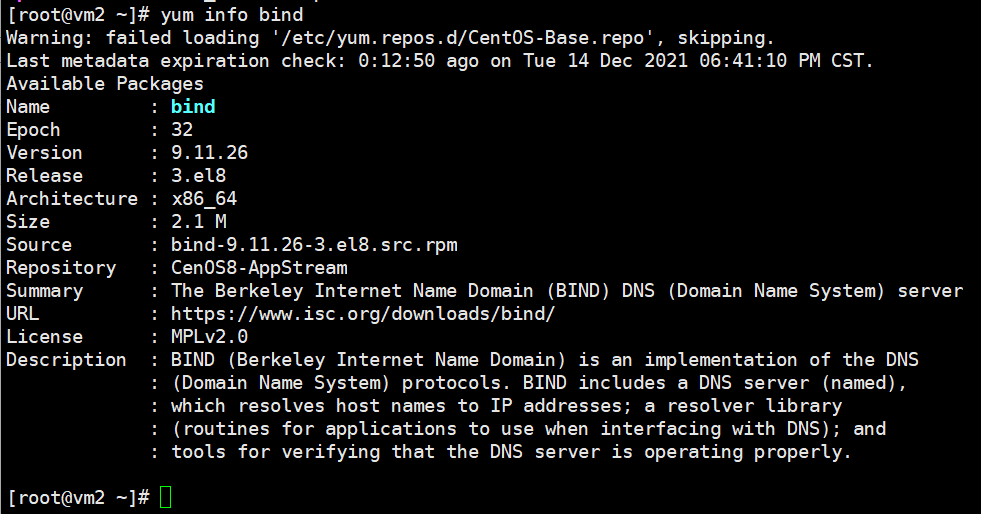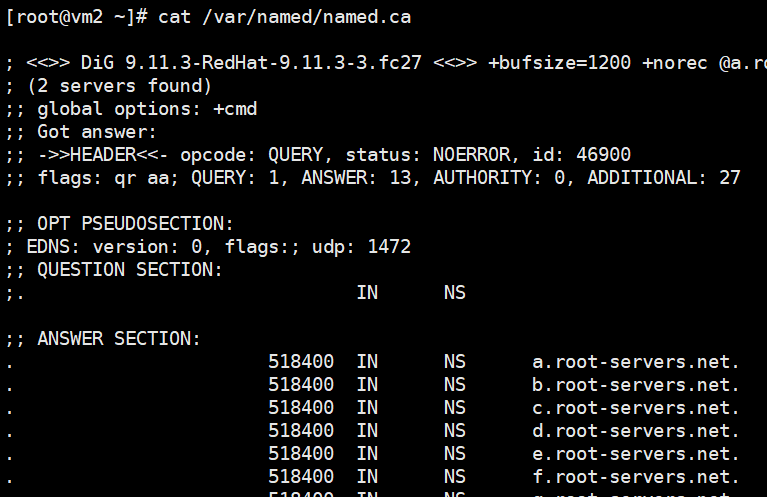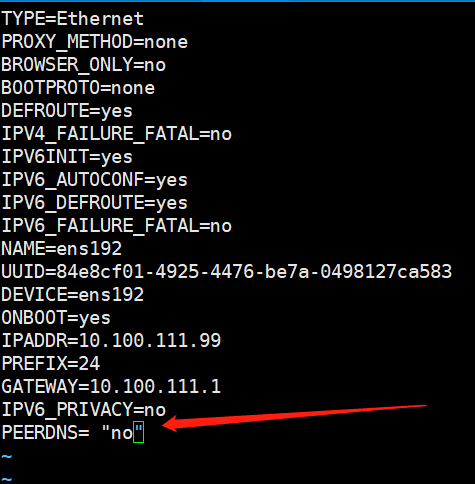CentOS8配置本地DNS
为了完成VCSA的完整安装。需要在本地配置一台RedHat8的vm来作为本地的DNS
1.安装DNS服务
查询bind
[root@vm2 ~]# yum info bind
安装bind
[root@vm2 ~]# yum -y install bind
[root@vm2 ~]# rpm -ql bind
查看13个根域服务器文件:
[root@vm2 ~]# cat /var/named/named.ca

开启DNS服务,并添加防火墙端口:
[root@vm2 ~]# systemctl start named
[root@vm2 ~]# systemctl enable named
Created symlink /etc/systemd/system/multi-user.target.wants/named.service → /usr/lib/systemd/system/named.service.
[root@vm2 ~]# firewall-cmd --permanent --add-service=dns
success
[root@vm2 ~]# firewall-cmd --permanent --add-port=53/tcp
success
[root@vm2 ~]# firewall-cmd --permanent --add-port=53/udp
success
[root@vm2 ~]# firewall-cmd --reload
success
[root@vm2 ~]# ss -untl
查看修改网卡信息:
[root@vm2 ~]# vim /etc/sysconfig/network-scripts/ifcfg-ens192
PEERDNS= "no"
电脑重启后 /etc/resolv.conf 的namespace不会恢复至系统默认
[root@vm2 ~]# systemctl restart network-online.target
编辑DNS配置文件/etc/named.conf文件:
[root@vm2 etc]# cp -p /etc/named.conf{,.back}
[root@vm2 etc]# ll |grep named.conf
-rw-r-----. 1 root named 1705 Feb 18 2021 named.conf
-rw-r-----. 1 root named 1705 Feb 18 2021 named.conf.back
[root@vm2 etc]# vim named.conf
[root@vm2 etc]# cat named.conf // // named.conf // // Provided by Red Hat bind package to configure the ISC BIND named(8) DNS // server as a caching only nameserver (as a localhost DNS resolver only). // // See /usr/share/doc/bind*/sample/ for example named configuration files. // options { listen-on port 53 { 127.0.0.1; }; listen-on-v6 port 53 { ::1; }; directory "/var/named"; dump-file "/var/named/data/cache_dump.db"; statistics-file "/var/named/data/named_stats.txt"; memstatistics-file "/var/named/data/named_mem_stats.txt"; secroots-file "/var/named/data/named.secroots"; recursing-file "/var/named/data/named.recursing"; allow-query { localhost; }; /* - If you are building an AUTHORITATIVE DNS server, do NOT enable recursion. - If you are building a RECURSIVE (caching) DNS server, you need to enable recursion. - If your recursive DNS server has a public IP address, you MUST enable access control to limit queries to your legitimate users. Failing to do so will cause your server to become part of large scale DNS amplification attacks. Implementing BCP38 within your network would greatly reduce such attack surface */ recursion yes; dnssec-enable yes; dnssec-validation yes; managed-keys-directory "/var/named/dynamic"; pid-file "/run/named/named.pid"; session-keyfile "/run/named/session.key"; /* https://fedoraproject.org/wiki/Changes/CryptoPolicy */ include "/etc/crypto-policies/back-ends/bind.config"; }; logging { channel default_debug { file "data/named.run"; severity dynamic; }; }; zone "." IN { type hint; file "named.ca"; };
zone "example.com" IN {
type master;
file "example.com.zone";
}; include "/etc/named.rfc1912.zones"; include "/etc/named.root.key";
[root@vm2 etc]# systemctl reload named
[root@vm2 etc]# ss -ntul
[root@vm2 etc]# cat /etc/resolv.conf
# Generated by NetworkManager
search example.com




【推荐】国内首个AI IDE,深度理解中文开发场景,立即下载体验Trae
【推荐】编程新体验,更懂你的AI,立即体验豆包MarsCode编程助手
【推荐】抖音旗下AI助手豆包,你的智能百科全书,全免费不限次数
【推荐】轻量又高性能的 SSH 工具 IShell:AI 加持,快人一步
· .NET Core 中如何实现缓存的预热?
· 从 HTTP 原因短语缺失研究 HTTP/2 和 HTTP/3 的设计差异
· AI与.NET技术实操系列:向量存储与相似性搜索在 .NET 中的实现
· 基于Microsoft.Extensions.AI核心库实现RAG应用
· Linux系列:如何用heaptrack跟踪.NET程序的非托管内存泄露
· TypeScript + Deepseek 打造卜卦网站:技术与玄学的结合
· Manus的开源复刻OpenManus初探
· AI 智能体引爆开源社区「GitHub 热点速览」
· 三行代码完成国际化适配,妙~啊~
· .NET Core 中如何实现缓存的预热?